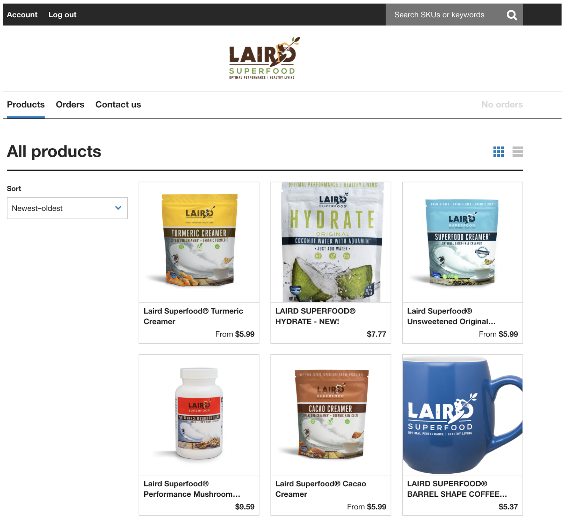The 2 A.M. phone calls for caffeine and healthy fat were going unanswered…
You see, even after hiring extra workers just to take wholesale orders for the popular coconut-based creamer and coffee Laird Superfood is known best for, the company was missing out on orders and leaving money on the table.
“We were in bed when some of our wholesale customers were calling to order,” says Paul Hodge, Laird’s CEO.
Some smaller mom and pop wholesale customers have to place their orders at seemingly odd early morning hours because they have to man checkout lines and serve their customers during the day.
“Four or five in the morning is the only time they have to do their inventory work,” Hodge says.
During normal business hours Laird’s phones would ring constantly as demand from wholesale customers grew. Unfortunately, the only ways to place wholesale orders was via phone or email.
“It was a really labor-intensive and time-consuming process,” Hodge says. “We had to add to payroll and hire more staff just to take orders.”
The inefficient manual order taking process certainly wasn’t representative of the performance-boosting superfoods the company’s founder and renowned surfer Laird Hamilton had dedicated his life to creating.
Hamilton routinely tames 70-foot potentially lung-crushing ocean waves...
Would the complexity of a growing business wipe him out?
Optimizing Coffee
A human guinea pig on a surfboard…
That’s how you might describe Hamilton’s lifetime of self-experimentation and quest to find the right combination of nutrients that would offer him the energy and focus to stay atop some of the world’s biggest waves for five to six hours at a time. Hamilton’s epiphany came when he found himself adding a scoop of butter to his morning coffee.


“I recognized the need for healthy fats," Laird said. "And I absolutely love a good cup of coffee, so I started experimenting with different ways to combine the two. I knew there had to be a better way- better sweetener, better fat, better creamer, better nutrition.”
Laird Hamilton, Co-Founder, Laird Superfood
The result is a non-dairy, coconut-based, alternative to traditional creamers designed to offer a nutrient-dense coffee booster that gives extreme athletes, moms, and business professionals the energy they need to sustain peak performance. Paired with a complex, organic coffee offering and uniquely packaged to stay fresher longer, Hamilton and his wife, volleyball pro Gabrielle Reece, launched Laird Superfood in 2015.
“It took Laird twenty years of experimentation to come up with the perfect formula,” Hodge says. “This is a gateway that helps you be a better version of yourself and puts more gas in your tank.”
Instead of the near-instant crash following a regular cup of coffee, the team at Laird says its non-pasteurized creamers offer healthy fats that caffeine molecules bind with and are broken down over time, which regularly releases energy that’s sustainable over longer periods of time.
“I feel better and I’m more productive,” says Luan Pham, Laird’s marketing chief. "It’s a clean burn and I’ve lost twenty pounds since coming to work here seven weeks ago. I’m promoting a product I know works. I’m proof, you can actually feel a difference.”

Soon though, the company would need a pick-me-up of its own…
Like a regular cup of coffee, Hodge says BigCommerce, Laird’s commerce platform at the time, quickly left the Laird team feeling rundown and depleted. Specifically, Hodge says the platform didn’t offer the integrations or features necessary to scale its subscription coffee and wholesale businesses.
“We needed to switch,” Hodge says. “We needed a robust platform that offers an automated wholesale portal customers can access anytime they like.”
Multi-channel made simple
Shopify offers 16 native sales channels across social, Amazon, retail, wholesale, and more …
All without plugins or custom development.
You’d be forgiven if you mistook the company’s headquarters for something akin to a telethon from the 1980s. Staffers were manually entering wholesale orders as fast as they could but the phone kept ringing.
Not even Hamilton’s super creamer and coffee combo could offer workers the energy necessary to keep up night and day.
That killer wave that Hamilton always hunted down…
Was now seemingly targeting the business he spent decades building.
Wholesale at Scale
The phones stopped ringing seemingly overnight...
But the newfound silence permeating Laird’s headquarters in Sisters, Oregon was a sign the company had indeed tamed the wave of complexity threatening to drown it. After migrating to Shopify and upgrading to Shopify, Hodge and his team now had the robust wholesale platform they so desperately needed to scale.
“It’s really exciting Shopify had already built exactly what we needed,” Hodge says. “It works great and saves us tons of time.”
Besides automating processes Laird’s employees once had to complete manually, the wholesale portal has also significantly improved the customer experience in three key ways:
- Order Placement- customers log in to the portal and place orders anytime they want without having to call or email a Laird representative
- Order History- customers logged in to the portal are able to easily access their invoice history which Laird says is a popular feature and gives customers instant visibility they lacked before
- Order Tracking- if customers misplace or do not receive a confirmation email with an order tracking number, they can easily retrieve the number themselves and track the order’s status in real time
“Customers just love it,” Hodge says. “They log in and everything they need is right there on their dashboard.”

Today, wholesale accounts for approximately a quarter of Laird’s sales. However, Hodge estimates wholesale, which is the company’s fastest growing segment, will account for 75% of sales within two years.
“Shopify lets us scale when we need to,” Pham says.
Since moving their business to Shopify:
- 2017 Q2 year over year sales growth is 550%
- Sales are growing 15% month over month
- The 12 person business has now grown to 29
Importantly, the wholesale channel is also causing Laird to rethink how it builds its team. For instance, instead of hiring two employees to answer the phones and manually take wholesale orders, Laird can add those workers to its marketing and manufacturing teams and increase productivity.
“Being able to automate the wholesale process changes how we build our team,” Pham says. “It prevents us from missing 2 A.M. orders and keeps our customers from having to wait to place an order until we’re in the office. It just solves so many problems.”

Besides integrating individual wholesale customers, Laird recently used the portal to land a large multi-store wholesale customer who used the portal to reorder within a week. It’s a channel Hodge suggests is also saving the company money.
“It’s fair to say that having the wholesale portal will save us the equivalent of one employee a year,” Hodge estimates. “That’s $50,000 – $60,000 a year and covers the cost of Shopify several times over.”
That’s something a bean counter might salivate over …
But it doesn’t explain why the rank and file at Laird refuse to take lunch breaks.
WARNING: Dirty Word Ahead
There’s only one rule to be followed at Laird Superfood…
“If you can’t pronounce it you won’t find it in our products,” Hodge says proudly.
It’s a clean ingredient label dominated by whole foods and void of extracts, derivatives, and chemicals the Laird team suggests are difficult for the body to break down. “I’m an ex-New Yorker and spent $30 a day on coffee,” Pham says. “Now I drink one or two max and I have the energy I need to perform all day.”
It’s not just Pham though…
Laird’s employees, presumably fueled by the superfoods they make and sell, routinely skip their lunch breaks and work out in the company’s gym instead. “We give them the option and actually pay them if they want to exercise,” Pham says. “About 95% of them choose to work out and afterward they have more energy and are more productive.”

It’s just what the company needs as it scales…
The idea is to quickly increase volumes to reduce the company’s COGS, build a brand online, and eventually land the product on the shelves of the major big box retailers. Laird estimates at its current growth rate, it can source enough ingredients that meet the company’s stringent quality standards for five years.
After that, expect Laird to invest in farms around the globe to ensure it has the ingredient supply necessary to meet the expected demand.
One thing Laird will not be investing in?
Another ecommerce platform.
“Migration is a dirty word around here,” Hodge says. “We’ve tried every platform because we’re nimble and we switch when something isn’t working. It’s costly to switch and migrating is a major upheaval. We’re married to Shopify and love the technology. Save yourself the time and money and just start with Shopify and you won’t need to worry about switching as you grow.”
Read more
- rockflowerpaper Saved $200K Per Year Switching from Symphony Commerce
- How a Seller of Outlandish Party Costumes Optimized Its Warehouse to Grow 400% & Compete With Amazon
- Ryonet Finds Ease and Speed for Both Its Online Wholesale Businesses
- John’s Crazy Socks, With $4M+ In Sales Over Just 22 Months, Is Not a Cute Story
- Want to Get on Shark Tank? Shopify Plus Merchants Share How to Be Selected & Kill It Under Pressure
- How Two Minnesota Companies Customize Shopify Scripts to Offer Dynamic Checkout Pricing & Grow Mobile Revenue 340%
- How Discount Hockey Lifted Mobile Conversions 26% and Uses Shopify Plus to Sell On & Off the Ice
- Why Marshawn Lynch Chose Shopify Plus to Power His Flagship Store Two Days Before Retiring from the NFL
- How Memobottle Reimagined the Water Bottle & Sparked a Movement That Crashed the Oscars
- How to Optimize Your Mobile Checkout Flow


